
Mixmax sits in my email inbox all day every day.
Let’s say I’m writing canned messages to people. After enough people open and click through it, I can actually share the template and analytics with my team. From a sales perspective, if we can all see the same templates and we can all see what’s performing well, that’s going to move the needle.
I also like being able to see who’s opening emails, on what devices, how many times they’ve opened them, and which location they’re coming from. I like seeing all those metrics. In the Mixmax dashboard, you can set up email sequences as well.

For example, I have a sequence for a book. I can set up different sequences and send these to different people. All I have to do is upload a CSV list and use a tool like Hunter to find emails.
Related Content: 9 Cold Email Case Studies with Great Reply Rates
In this particular case, I’m trying to get people to be included in my book. There’s a variable for the first name, so in the CSV I’ll put the first name.
Then I try to customize the first line of the email. The rest of it is a template, but if I can customize each first line, I’m going to have a higher response rate because it’s customized to that individual.

I can change the subject line as well and I can have different stages that map to different emails in the sequence. That way I’m not sending everything in a completely automated manner, because that just doesn’t perform as well. Something that is semi-personalized works much better.
Frankly, I’d rather reach out to 100 people and get 20-30 responses than reach out to 1,000 people and only get five responses because it’s so generic.
For this particular outreach email, the open rate was 50% and 6% actually clicked through. Ultimately, I got a 22% response rate.
Anytime you can get a response rate around 10-15% or higher, you’re in a good spot.
Your job is to elicit some kind of response. That’s what you’re really aiming for at the end of the day.
Mixmax also lets you keep track of all sorts of other things, like the emails that I have to send out later and the reminders about people I need to get back to. This tool is super helpful and makes my life a lot easier. If you buy subscriptions for your team, you can also see what they’re doing, how active they are, what their response rates look like, and what their templates look like.
Related Content: How to Get Higher Email Open Rates (Without Being Spammy)
I’ve used a lot of different sales tools over the years, but I think Mixmax is probably my favorite one because I have the ability to customize messages and see what my team is doing.
But there are a lot of different tools out there. I’ve talked to a lot of different people on my Growth Everywhere podcast who use other sales tools, but right now Mixmax is my favorite because it’s simple to use and a lot of the other ones are a bit too bulky for my taste. Check it out!
This post was adapted from Eric’s Facebook Live videos: Growth 90 – DAILY live broadcasts with Eric Siu on marketing and entrepreneurship. Watch the video version of this post:
This post originally appeared on Single Grain, a growth marketing agency focused on scaling customer acquisition.
It’s enough to strike fear into even the most experienced of marketers and bloggers. It can seem like torture by tedium. It’s often the stuff of nightmares. What is this unholy monster?
The content audit.
A well-executed content audit done on an annual basis can deliver big insights into your website’s blog and content marketing strategy that far exceeds its ho-hum reputation.
Too often, we post something and then never go back to it again. Years later, it’s outdated, stale, and completely irrelevant. Good practice demands that we return to our content periodically to ensure that everything is as fresh and beautiful as the day it was released to the world.
A content audit involves taking a look at all the content on your website and assessing its relative strengths and weaknesses in order to prioritize your future marketing activities. It’s a qualitative assessment and evaluation based on the KPIs (Key Performance Indicators) that you select beforehand.

This process should not be confused with a content inventory, which is simply an accounting of all these different assets. In other words, it’s a quantitative collection. Although a content inventory is part of the audit process, the audit itself goes much further in depth. The Content Analysis Tool (CAT) can make content inventories a snap. When you start off on the right foot, the rest of the journey is that much easier.
When performed correctly, a good audit will help you to answer questions about the content pieces on your site:
An audit will tell you where you need to focus your future efforts in terms of both an SEO and content marketing perspective. And it can even give you insight into potential changes that will improve your lead generation, sales, and marketing processes.
If you’re struggling to understand your visitors’ behavior on your website or why your current marketing initiatives aren’t working, a content audit is easily one of the best things you can do for your business.
But before we get into the step-by-step process of conducting one, you need to answer a few questions.
There could be any number of reasons. There’s no one correct approach for conducting a content audit – the exact steps you’ll take will depend on your reasons for undergoing the process in the first place.
Typically, content audits are conducted for two primary reasons:
Of course, there’s no reason you can’t do both. While you’re digging through your SEO metrics, it’s easy to jot down your content marketing data as well. Or you might be approaching your content audit from a slightly different perspective. Whatever the case may be, being clear about your intentions ahead of time will help to streamline the process and minimize extra effort. Know why you’re doing before you start doing it.
A good content audit is a time-consuming process. If you’re currently swamped with other priorities, undertaking such a massive project may not be the best use of your time or energy. If you can’t devote the proper resources to it, it’s better to wait until you can.
But if the project must be done, keep in mind that you do have options. Instead of undertaking the entire audit process by yourself, delegate some of the data-gathering steps to another employee in your organization or to an outsourced worker hired through sites like Guru or Upwork.

You also have the option of completing only small sections of the audit at any given time, or paying for tools that help to automate parts of your research process (gone are the days of having to manually sift through everything yourself!). More on this later.
Before you begin, be clear about the reason you’re conducting a content audit in the first place. If you aren’t going to take action based on the data that your audit produces, you might as well skip the process altogether. An audit for the sake of an audit is a waste of time and resources.
Any of the following are potential content audit goals. You may have others that are not on this list, and you’ll likely have more than one in mind as you go through it.
That’s the theory. Now let’s put it in practice.
To help illustrate how to do a content audit, we’ve created John, a business owner with a heart of gold. He runs a small software company that’s developed an SaaS budgeting tool.

He’s invested in content marketing for about a year, but he isn’t sure whether all the time he’s spent blogging, creating videos, and releasing infographics has paid off. As a result, he decides to conduct a content audit to see how his individual content pieces are performing and what – if anything – he should do differently in the future.
Because John only has five employees – all of whom are busy wearing multiple hats already – he decides to take on the audit process by himself. Because he’s a busy guy, he keeps the scope of his audit small, checking only the content he’s created in the past year and tracking only a few variables that indicate success to him.
Remember, the size and scope of your audit is completely up to you. This is not an all-or-nothing scenario. Do what you can when you can do it.
We’ll revisit John a little later on.
If you’ve finished your homework (you did answer the questions above, right?), it’s time to get started. Try the following three-step process to complete your website’s first content audit (and feel free to amend it for subsequent ones):
Unsurprisingly, the first step in completing a content audit is to find all your content. You have two different options for doing so:
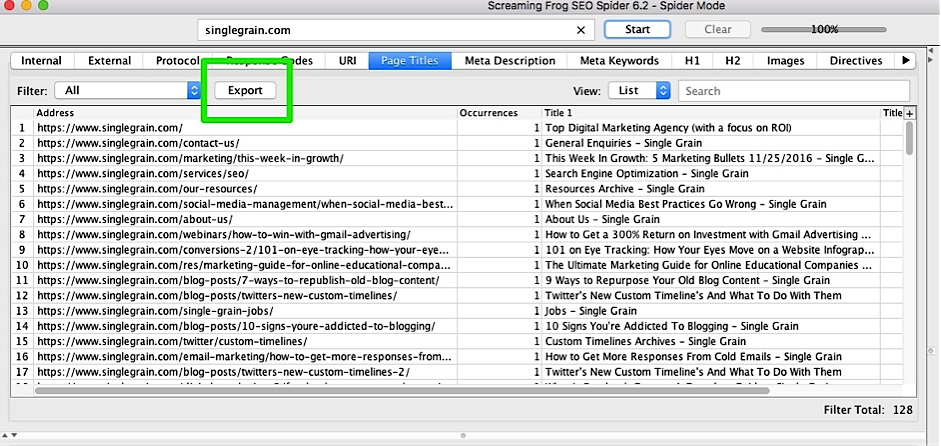
Enter or import all the URLs you find into an Excel or Google Docs spreadsheet, leaving plenty of columns for the data you’ll gather in Step #2. Or, if you’d rather not reinvent the wheel, you can add your links to any of the following freely-available content inventory and audit templates:

Most audits use a spreadsheet to organize the data, but it’s not the only way. If you despise Excel for some reason (no judgement), you could opt for the WordPress Content Audit plugin. This tool allows you to create a content inventory directly in the Edit screens in WordPress. Set a few conditions, and you’re good to go.
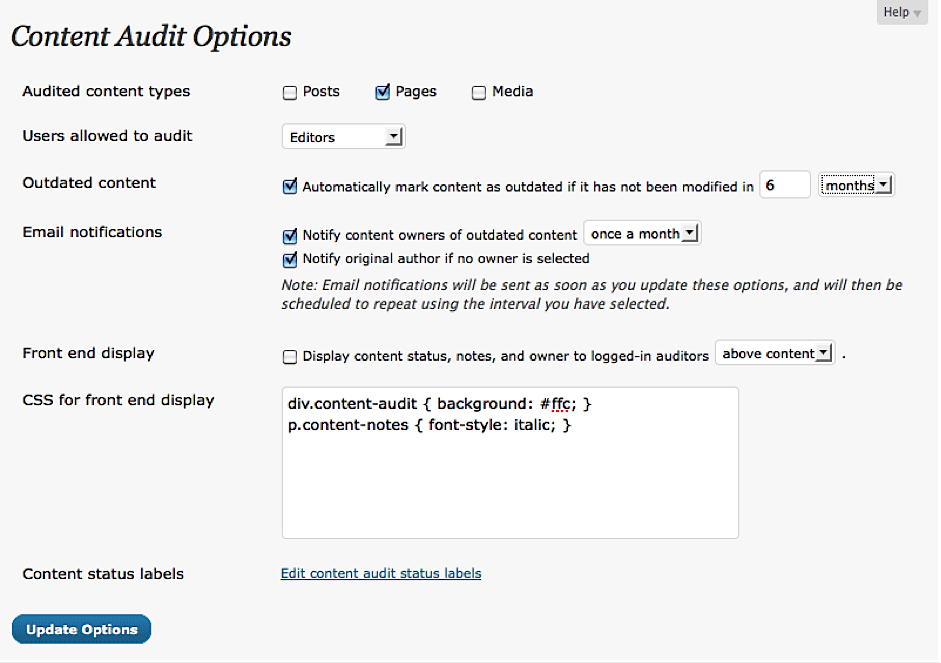
Just go with whatever you’re most comfortable with. Set yourself up for success by using the tools and methods that work for you.
Which brings us back to John, our savvy business owner from Seattle. Because his site is small and he’s pressed for time, he uses Screaming Frog to create the URL list pictured below:
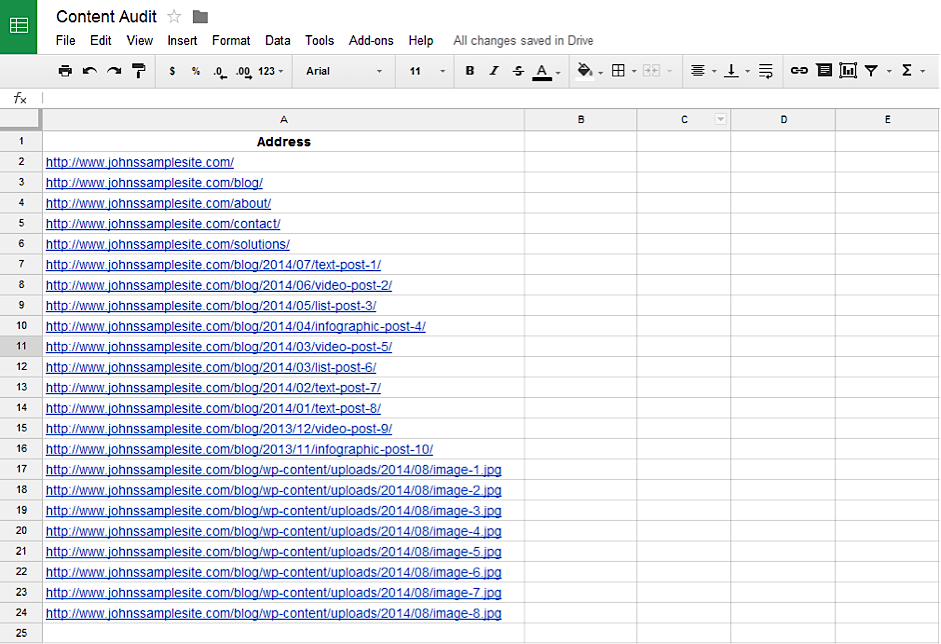
To upload your CSV file into Google Sheets, go to File > Import > Upload and select the saved file from your computer. Easy-peasy.
John is well on his way with a handy list of all his URLs. Step 1? Check!
Remember those columns I mentioned earlier? Now’s the time to set them up and fill them out.
The exact data points you’ll want to gather will, again, depend on the goals of your audit, as well as the complexity you want to achieve. Although the lists below may look daunting, it isn’t necessary to collect data on every possible variable. In fact, you may be able to achieve the goals you set for yourself with only a handful of possible data points.
Potential SEO data points to gather (many of these are automatically generated by Screaming Frog):
Potential content marketing data points to gather:
Other items to track:
Once you’ve selected the data points you’ll measure as part of your content audit, label a column in your spreadsheet for each one.
Now comes the fun part — time to do the heavy lifting of data collection (and yes, “fun” is subjective)!
Let’s get back to our pal John…
Since his primary goal is to determine what’s working with his current content marketing strategy, he decides to evaluate the following metrics:
While he could track other pieces of data as part of his audit – and probably glean additional insights from doing so – analyzing only this limited number of metrics makes it possible for John to complete his content audit while juggling his other responsibilities. The way he looks at it, he can always go back and add more to his analysis if he has the time down the road.
To find the data points he’s decided upon, John uses the following resources:



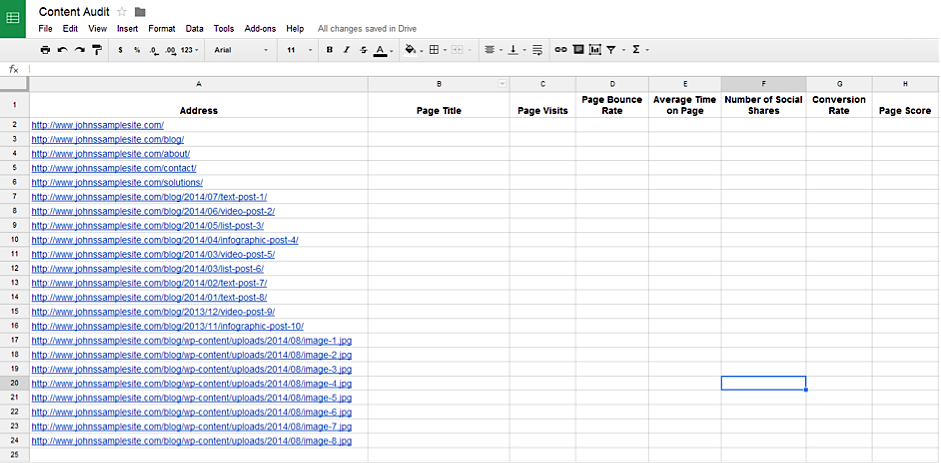
Learn More: How to Set Up Goals and Funnels in Google Analytics
Once John is done gathering this data, he goes back through his list and assigns a score to each page on an “A – F” rating scale of his own creation.
Pages that receive “A” scores are his cream-of-the-crop, top-performing pages, while those that earn “F” scores are ones he’s embarrassed to find on his site. He also adds a note to his spreadsheet showing the date that his audit was created for the purpose of planning future audits.
And even though John didn’t do this, you could also head over to the Google Search Console to pull even more conveniently organized data. Click on Search Analytics, select Pages, and check Clicks, Impressions, and CTR to get a quick snapshot of how individual pages are performing.

There’s a “Download” button at the bottom of the page if you want to export the data as a CSV file and add it to your ever-expanding spreadsheet.
If your site is large, expect the data-gathering process to take a long time. It’s not uncommon for audits to take days, weeks or even months to complete, depending on the size of the website and the organizational resources that are available for the process.
But even if your content inventory is completed quickly, you’ve still got another important step to take – actually putting all your information to use.
To be sure you’re getting something substantive out of your content audit process, you need to establish a set of recommended actions you’ll take once the audit is complete. And in order to do that, you need to dive into the data you’ve collected in order to draw conclusions.
It could be as simple as adding one more column to your spreadsheet: “Action.”
Here, you make the call as to what should happen to each individual content asset, like:
Unfortunately, there are no hard and fast rules that say, “If your content data indicates [this], do [that].” Instead, you’ve got to look at the data you’ve gathered and see if you can identify any trends that could inform your eventual recommended actions.
Take a look at John’s spreadsheet below and see if anything jumps out at you:

Here are a few observations you might have made:
After further exploration, John decides to take the following actions after the completion of his content audit:
An audit might focus on content quality, the customer experience, content performance, or any combination of these.
Use the results of your content audit to come up with 5-10 actions you’ll take after completing it, based on any patterns that emerge from your data.
Then, set deadlines for yourself in order to put these actions into play and block out whatever time you’ll need to do so on your calendar. Add a deadline right into your spreadsheet (when it comes to columns, you can never have too many!).
 One important thing to note here. When you’re staring at the mountains of data your content audit may generate, it’s easy to find yourself struck down by analysis paralysis. Basically, there are so many conclusions you could draw and so many things you could do, that you wind up doing none of them. Don’t let yourself fall into this trap.
One important thing to note here. When you’re staring at the mountains of data your content audit may generate, it’s easy to find yourself struck down by analysis paralysis. Basically, there are so many conclusions you could draw and so many things you could do, that you wind up doing none of them. Don’t let yourself fall into this trap.
Content marketer Pawel Grabowski offers many helpful suggestions to combat analysis paralysis, such as focus on what’s most important, break decisions down into bite-sized steps, and don’t worry about being perfect!
As long as you’re tracking your metrics and regularly revisiting the content audit process, you’ll see these shifts occurring and be able to remedy them long before they become big problems plaguing your site’s performance.
If you’ve caught the auditing bug while going through the content analysis process, you can always take the skills you’ve learned to expand your audit beyond the borders of just your website.
So now you know everything there is to know about your own content. But unless you have a truly unique product or service, you’re not the only show in town. You have competition for customers.
The performance of your content will always be tied, in some ways, to the content that your competitors put out. Even if their pieces don’t directly prevent visitors from seeing yours, there is a limited number of consumers out there and they all have a finite amount of attention. If they’re using all their energy focusing on the competition’s content, they may not have enough mental focus left to pay attention to yours.
Conducting an audit of your competitor’s content is similar to assessing your own, but with a few limitations. There are a few metrics that you may not be able to pull without having direct access to your their website and accounts. Bounce rate, average time on page, and conversion rate are three in particular that are difficult to discover without accessing the site’s Google Analytics profile or marketing automation account.
But that said, there are still plenty of different things you can track. You can evaluate the number of links pointing at your competitor’s content pages using tools like Majestic Site Explorer or BuzzSumo’s Backlinks.

You can measure social shares by looking for a share counter on the post itself, or entering the post URL into a service like BuzzSumo to see a detailed breakdown with their Most Shared feature. It might not be a complete audit, but even conducting this limited level of assessment will give you plenty of actionable data on areas where your competitors are currently outperforming your site.
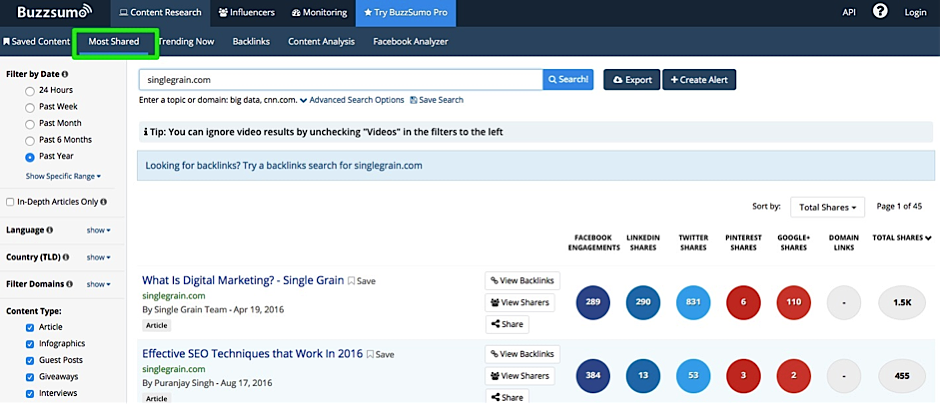
What works for them? Can you improve on it in some way (the Skyscraper Technique is a fabulous way to bring in oodles of traffic)? Which sites are linking to them that might potentially link to you if approached with a powerful piece of content or a fantastic guest post idea?
Another way to expand your content audit is to include your off-site content assets (if they’re relevant to your audit goals). For example, if you’re assessing the effectiveness of your content marketing efforts, you’ll want to include as much data as possible on any infographics, slide decks, or other external content pieces you’ve released to promote brand recognition and viral sharing.
Again, your ability to track the metrics listed above on these content pieces will vary based on the sites hosting them. Gather what you can, but also look for other types of data that are unique to external content sources.
As an example, looking at your Google Analytics account should show you the number of visits that each external piece sent to your site. Comparing referred visits across external content pieces can be a great way to determine the direction of your next big content release.
Check out Reporting > Acquisition > Channels for a general breakdown of traffic by organic, direct, referral, and social (and select Referrals if you want to see the specific points of origin).

And if you utilize custom URLs with UTM parameters, for example, you can instantly see what content is sending the most traffic your way from offsite.
In addition to assessing your offsite content pieces, you can apply the audit process to your other marketing channels. If you run print ads in trade publications, try to determine how many inquiries you’ve received from each ad (hint – this is easiest to do if you record the source of your first touch with a new prospect in your CRM after your first conversation).
Or take a close look at your e-mail marketing campaigns. Is the content in your autoresponders still up-to-date? Do you have some messages that have a higher open rate than others? Services like MailChimp and AWeber have robust analytics at the ready.
Read More: 5 Ways Cold Emailing Can Help Generate Backlinks
When it comes down to it, a content audit isn’t just a one-off process that you conduct once in a blue moon. It’s a mindset that you should apply to both your website content and the other marketing channels you use.
By carefully inventorying your existing content pieces and assessing the data you’ve gathered for each item, you can make informed marketing decisions that will help you to save time, cut costs, grow your brand, and improve your overall advertising ROI.
And remember, there is no one-size-fits-all solution here. Content audits can take many shapes, routes, approaches, and scopes. It all depends on your needs and your goals.
What content audit tools do you use to make it go a bit smoother? What insights did your last audit reveal?
Enter your email to get free instant access
Notifications